Humans are hunters and pose enormous threats to various animals, but are humans really at the top of the food chain?
Many animals are known to prey on humans, some more preemptively than others. These animals are not to be trifled with, as they can be very dangerous. We call them “man-eaters.”
The most dangerous animals that eat humans fall into different categories, from mammals to reptiles to fishes. Some examples are lions, sharks, crocodiles, and tigers.
Let’s delve more into some of these most vicious apex predators that are deadly to humans with reports and statistics.
Deadly Animals that Eat Humans
1. Tiger

- Scientific name: Panthera tigris
- Diet: Carnivore
- Conservation Status: Endangered
The tiger is a member of the Felidae family and the largest living cat in the world. This animal is very popular and can easily be recognized by the stripes on its body.
As an apex predator, it is a fierce hunter in its range. It goes a lot after ungulates and is known to attack humans too.
According to a recent report, tigers claim up to 50 people a year. Given that not all attacks may be documented, it could be more than this.1
That being said, these wild cats don’t go after people who are not in their territory.
The tiger’s population has dwindled considerably due to human activities and conflicts with humans. It is currently classified as endangered on the IUCN red list.
2. Hyena
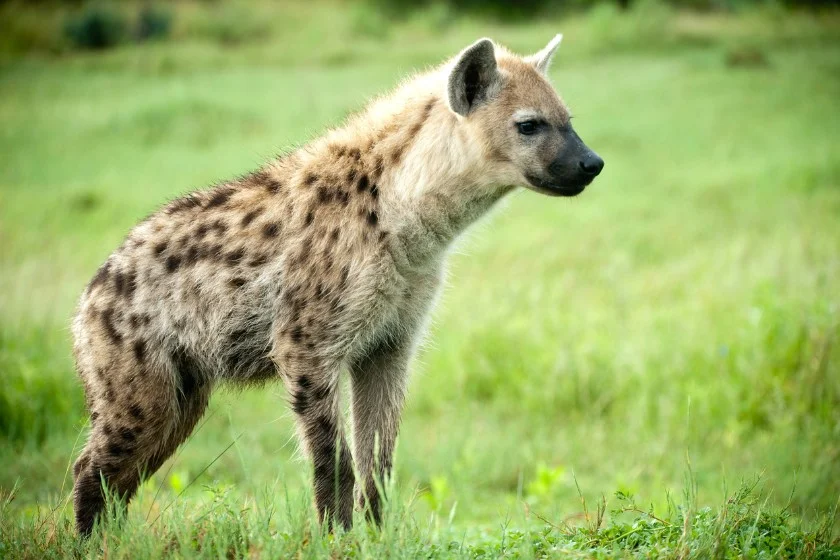
- Scientific name: Hyaenidae
- Diet: Carnivore
The hyena is a creature in the Hyaenidae family, and it is one of the smallest in the Carnivora order.
There are four living hyena species which are: the spotted, the aardwolf, striped and brown hyenas. Hyenas aren’t apex predators, but they have their share of danger.
While hyenas don’t attack humans as much as tigers do, there have been horrific cases, including a recent case where a pack of hyenas mauled a man to death in Zimbabwe.2
The spotted and striped species are especially considered dangerous, but they often prey more on vulnerable people. Cases involving the aardwolf and brown hyenas are rare.
3. Lion
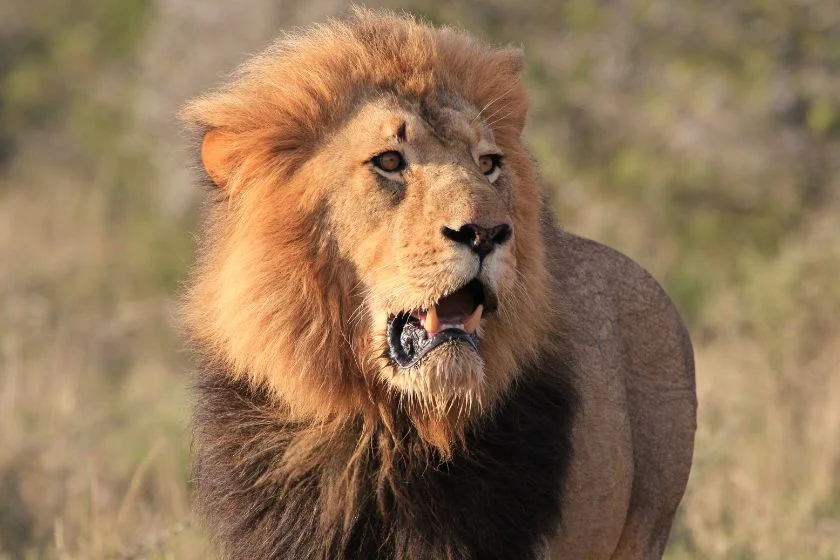
- Scientific name: Panthera leo
- Diet: Carnivore
- Conservation Status: Vulnerable
The lion is a member of the Felidae family alongside the tiger. It also belongs to the same genus as its wild cat neighbor.
The wild population can be found in Africa and Asia. It used to occur in America, but the species has since gone extinct in the region.
Lions actively hunt ungulates more than they do humans, but the conflict between these animals and humans has left casualties on both sides.
In Tanzania alone, lions caused over 500 deaths between 1990 and 2004.3
Human actions against lions revolve around hunting them, usually as trophies. They are currently classified as vulnerable due to this.
4. Leopard

- Scientific name: Panthera pardus
- Diet: Carnivore
- Conservation Status: Vulnerable
The leopard is in the Felidae family and part of the Panthera genus that comprises the tiger and lion.
It bears some resemblance to its relatives, except for the spots on its skin that others don’t have.
The leopard occurs in Africa and Asia. Similar to other creatures in its genus, the leopard is a hunter.
Humans are generally not safe whenever there’s a leopard around. It can go as far as breaking into a person’s house to find prey.
An infamous incident happened in India, where a leopard killed around 150 people before it was eventually shot dead.4
Leopards have paid many roles in human folklore and civilization. However, it also gets hunted down and is currently listed as vulnerable by the IUCN.
5. Dingo

- Scientific name: Canis familiaris
- Diet: Carnivore
- Conservation Status: Threatened
The dingo is a member of the Canidae family and is found in Australia. It has more scientific names than the one we listed here because of debates on its classification.
Other names include canis familiaris lupus, Canis lupus, and Canis lupus dingo. The dingo is not as ferocious as the felines we’ve seen so far, but as a canid, it poses its problem.
Dingoes are naturally suspicious of humans and tend to keep their space, but attacks can happen.
An example is that of a young boy who got mauled by a dingo at Fraser Island.5 Thankfully, dingo attacks are rare.
The dingo is classified as Threatened by the ESA. The IUCN no longer has it on the Red List because it is considered a feral species.
6. Wolf

- Scientific name: Canis lupus
- Diet: Carnivores
There are different types of wolves, the most popular being the gray wolf. It is a member of the Canidae family, the largest species within.
The gray wolf occurs in Europe, Asia, and North America. There are over 30 subspecies of gray wolves in existence today, including the domestic dog.
Wolves and humans have complicated relationships. On the one hand, the status of wolves is somewhat positive, and these wild dogs appear in many folklores.
On the other hand, there has been conflict between both sides. The Wildlife Society report on wolf attacks from 2002 to 2020 documented about 489 victims, most of which were by rabid wolves.6
Indeed, wolves are wild animals; while they should not be looked at as devils, they are also not saints.
If you are a frequent hiker or camper, you need to know how to survive a wolf attack in the wild.
7. Polar Bear
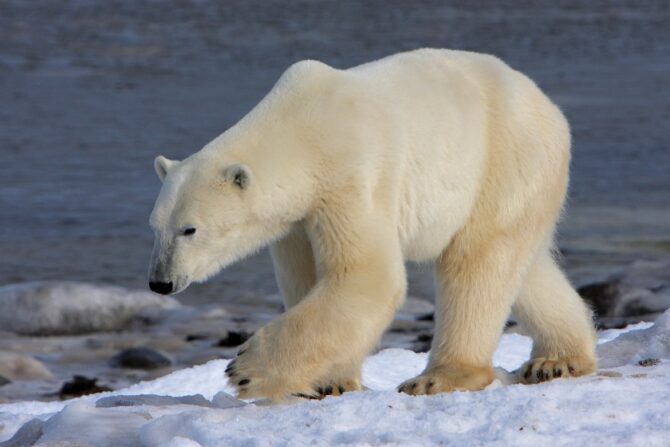
- Scientific name: Ursus maritimus
- Diet: Carnivore
- Conservation Status: Vulnerable
The polar bear is a member of the Ursidae family and is distinct from other bears in that it is purely white.
It occurs in the Artic circle, occurring in countries like the United States, Canada, Russia, Denmark, and Norway. It often spends its time on sea ice.
Polar bears are described as hypercarnivorous, and it feeds a lot on seals. Attacks on humans are rare, but when it happens, polar bears tend to go after more vulnerable individuals.
They may also attack if they feel threatened. There are recent documented reports of these predators attacking humans.7
8. Brown Bear

- Scientific name: Ursus Arctos
- Diet: Omnivore
The brown bear is a member of the Ursidae family and can be found in North America, Europe, and Asia. In North America, the brown bear is called the grizzly bear.
There’s also a particular subspecies in Alaska known as the Kodiak bear. In Europe, the brown bear is the national bear of many countries.
Unlike the aforementioned species, the brown bear is an omnivore. It is termed a common omnivorous animal because of the variety of its diet.
This bear hardly attacks preemptively, but cases aren’t uncommon. Campers and hikers are especially vulnerable to these attacks.
9. Black Bear

- Scientific name: Ursus americanus
- Diet: Omnivore
The black bear goes by the full name American black bear and can sometimes be called the baribal.
It is a native of North America, the only place they can be found. It is the smallest on the continent. Though limited in range, the black bear is widespread.
The black bear is an omnivore like the brown bear, and against humans, attacks are uncommon. However, they sometimes come across humans when ravaging campsites looking for food.
Hikers can also come across the black bear on their trip. Recent encounters, including a Minnesota woman killed by a black bear, prove that they’re among the most dangerous animals in the United States.8
If you are a frequent camper or hiker, check out this helpful guide on how to survive a bear attack.
10. Python

- Scientific name: Python
- Diet: Carnivore
The python is a member of the Pythonidae family, and the term refers to snakes in the genus Python. These snakes are found in Africa and Asia.
Some examples of python species include the Burmese python, the Indian python, the Borneo python, and the Angolan python.
The python is a nonvenomous reptile, but you can’t underestimate it based on a lack of venom. It is considered dangerous and can swallow a human whole.
An unfortunate event happened in Indonesia when a 7m (23ft) long python swallowed an Indonesian woman, and this is not the first time a python has eaten a human.9
11. Komodo Dragon
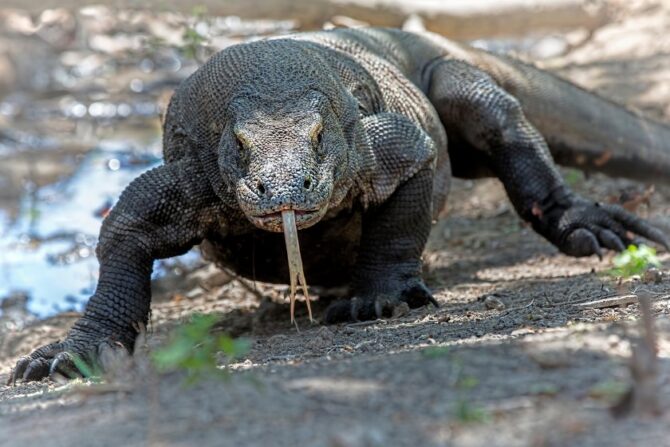
- Scientific name: Varanus komodoensis
- Diet: Carnivores
- Conservation Status: Endangered
The Komodo dragon is a member of the Varanidae family, also known as the monitor lizard family. This explains why it is also called the Komodo monitor.
It is endemic to Indonesia, where it inhabits the Komodo, Rinca, and Flores. The Komodo dragon is the largest lizard species still alive today.
As a big lizard, the Komodo dragon is an apex predator in the islands it stays in. Attacks on humans are infrequent but are still a reality.
In 2007, a Komodo made the news by killing an 8-year-old, making it the first fatal attack in 33 years on a human by a giant lizard.10
12. Crocodile
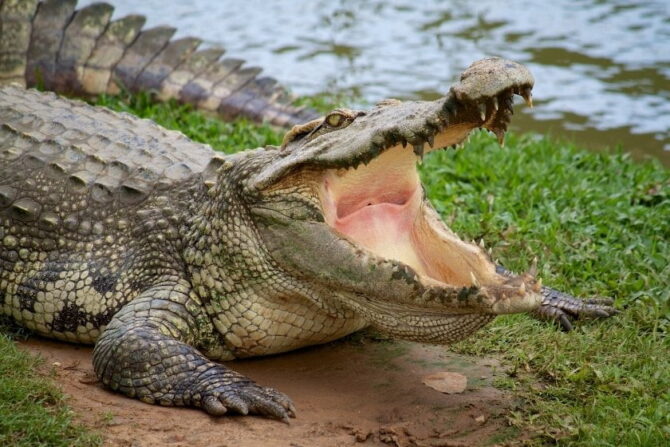
- Scientific name: Crocodylidae
- Diet: Carnivores
The crocodile is any reptile species that fall under the Crocodylidae family. Some examples are the saltwater crocodile and the Nile crocodile.
It is found in the tropical regions of Africa, Asia, Australia, and the Americas.
Crocodiles are among the most well-known dangerous animals that eat humans and should be avoided.
Their attacks are preemptive and often deadly. Unlike some other animals that may not attack unless provoked, the crocodile needs no other motivation except the need for a next meal.
According to James Perran Ross, a wildlife ecologist at the University of Florida, official estimates show that crocodiles kill up to 1,000 people in a year, making these reptiles 100 times deadlier than sharks.11
13. Alligator

- Scientific name: Alligator
- Diet: Carnivore
Alligators and crocodiles are similar and belong to the same Crocodilia order. Some people use the term “crocodile” to refer to alligators.
However, they are distinct. Alligators refer to species in the alligator genus and of the Alligatoridae family. There are two species, the Chinese and American Alligator.
Alligators are also not as feared as crocodiles but have a man-eating reputation, making them among the most dangerous reptiles.
Though they are not preemptive like crocodiles, there have been fatal cases of alligator attacks on people.12
14. Piranha
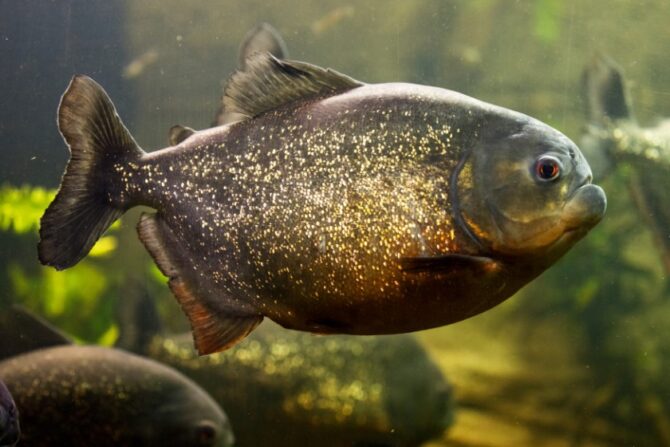
- Scientific name: Serrasalmidae
- Diet: Carnivore
The piranha is a fish in the Serrasalmidae family, all of which are freshwater creatures.
You’d find them in lakes, reservoirs, and rivers around America. Examples include the red-bellied piranha and the red-eye piranha.
Piranhas have always had a bad reputation, and it’s not hard to see why. These dangerous fish can attack a human if provoked, leading to numerous casualties.13
15. Shark
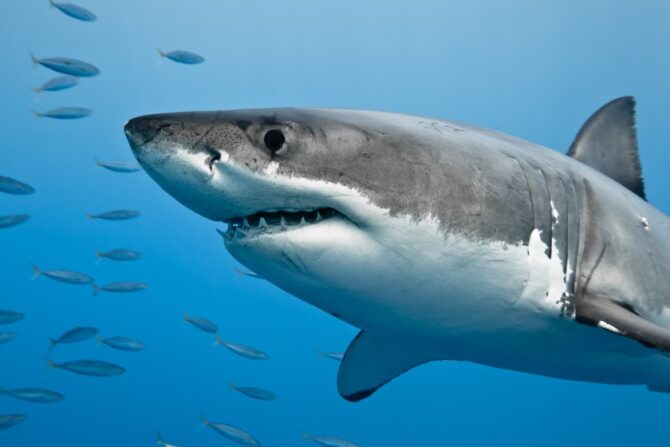
- Scientific name: Chrondichytes
- Diet: Carnivore
The term “shark” refers to a large group of sea creatures in the class Chrondichytes, with many species like the whale shark, the great white shark, the frilled shark, and the horn shark. These animals are large and known for their teeth.
Sharks are known to be dangerous, and that’s accurate. However, as we’ve said above, they are not as dangerous as crocodiles.
Sharks often approach humans out of curiosity and may attack if provoked.
Final Thoughts: Avoid These Real-life Man-Eaters
Humans are often considered apex predators because of their ability to dominate and exploit most other species in their environment.
However, in many ecosystems, humans are not at the food chain as they are preyed upon by other species, such as large carnivores.
These man-eating animals listed above should rightfully be avoided as they won’t hesitate to consider a human as prey.
However, they still have their roles to play, so they should be protected from extinction. Unfortunately, many of them are going down that path.
References & Notes
- Cursino M. 2022. Tiger that killed nine people in India shot dead. BBC News.
- Kolirin L. 2020. Hyenas dragged a man from his bed and mauled him to death. CNN.
- Thompson H. 2015. Yes, Lions Will Hunt Humans if Given the Chance. Smithsonian Magazine.
- Vaughan D. 6 Real-Life Man-Eating Animals. Britannica.
- Wondracs A. 2022. New details emerge young boy was nearly mauled to death by a wild dingo. Daily Mail Online.
- Frey D. 2021. Report documents wolf attacks around the world. The Wildlife Society.
- Jackson A. 2024. A polar bear killed a woman and a boy after chasing residents in Alaska town. CNN.
- Osborne M. 2019. Bear kills Minnesota woman while she’s searching woods for her dogs. ABC News.
- How a giant python swallowed an Indonesian woman. BBC News.
- Attewill F. 2007. Boy killed in dragon attack. The Guardian.
- Calderone J. 2015. Here’s why crocodiles are 100 times deadlier than sharks. Insider.
- Mendoza J. A South Carolina woman died in an alligator attack. USA Today.
- Richard L (Fox News). 2022. Piranha attacks in Paraguay leave 4 dead, more than 20 injured this year. New York Post.






